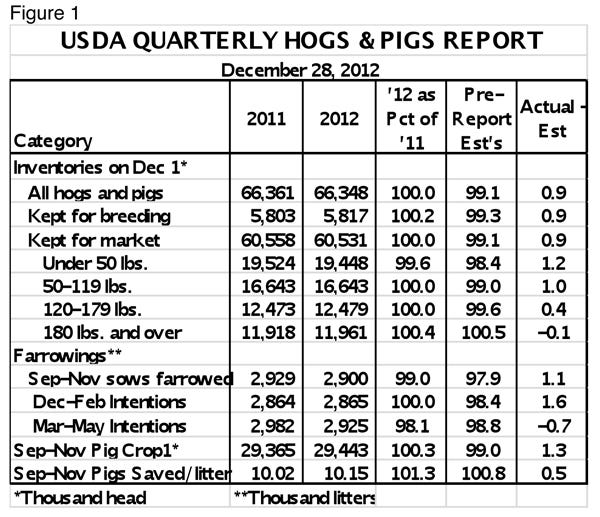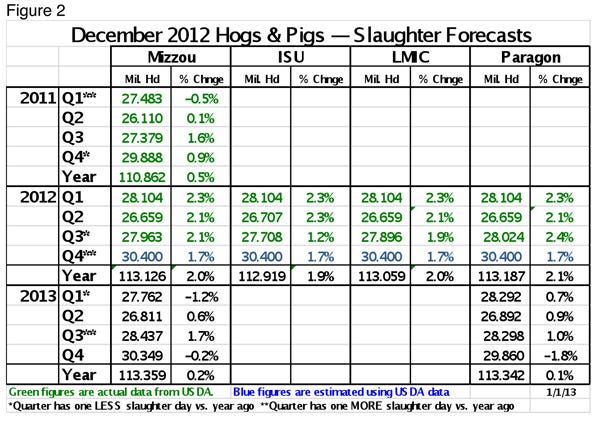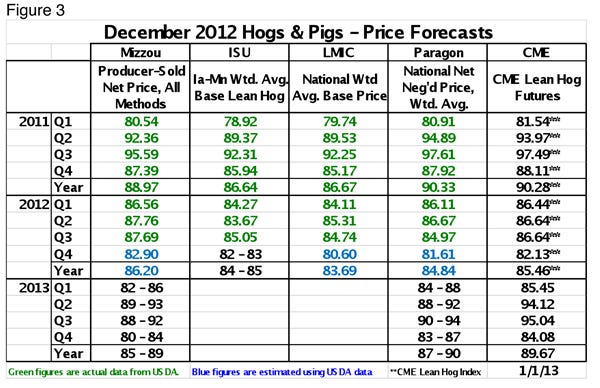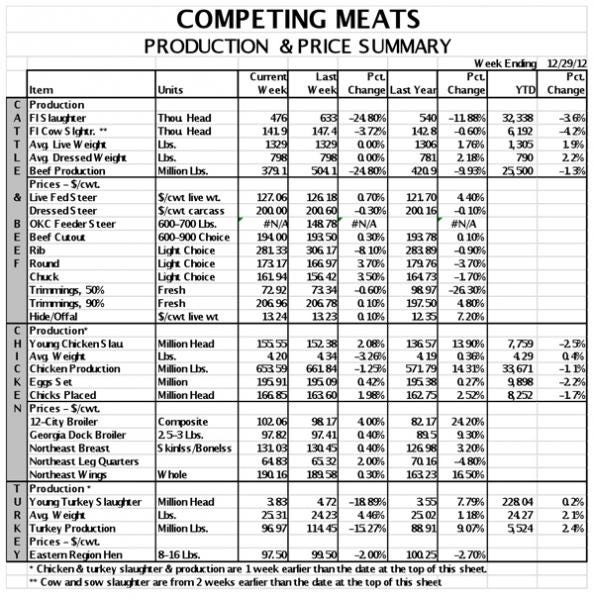Hogs & Pigs Report May Reflect Producers’ Staying Power
USDA December Hogs and Pigs report was a bit of a bearish surprise as virtually every number was larger than was expected by analysts surveyed before the report’s release.
January 2, 2013

USDA December Hogs and Pigs report was a bit of a bearish surprise as virtually every number was larger than was expected by analysts surveyed before the report’s release. See Figure 1 for key data from Friday’s report.

USDA estimated that the Dec. 1 breeding herd numbered 5.817 million head, 14,000 (0.2%) larger than one year ago and 29,000 head larger than on Sept. 1. Most analysts, including me, expected some reduction of the breeding herd based on the extreme feed costs that began last summer. But as I have pointed out on many occasions this fall, the data simply have not supported those expectations with sow slaughter lagging year-ago levels in many weeks and gilt slaughter as a percentage of total barrow/gilt slaughter falling well below year-ago levels. There was never, in my opinion, a high chance of the massive liquidation, although I did not expect there to be no reduction or even some growth.
How could this be? There is always the possibility that USDA may have the numbers wrong. They sometimes make some big revisions, which they did in this report when they added 636,000 head to the March-May pig crop to account for the higher September-November slaughter. Those added pigs were the result of 63,000 added litters during the March-May quarter. Again, the number could be wrong, but I doubt that it is off by much.
Second, it could be irrational behavior by producers, but in my experience hog producers rarely behave irrationally. On the contrary, hanging on to one’s sow herd and trying to ride out a short-crop-driven cost surge is completely rational. Whether it is ultimately the right decision depends on whether it rains this spring and summer. If normal weather returns, corn supplies will be ample, costs will return to more reasonable levels and current futures prices, even after Monday’s sell-off, will be profitable.
Third, the numbers confirm that there was indeed more financial staying power among hog producers than we had anticipated. That staying power was the result of lower-than-believed losses in 2008 and 2009 and, quite possibly, higher-than-believed profits in 2010 and 2011. Producers are much better at managing margins now and this lack of reaction is, I believe, the result of these new abilities.
One analyst friend remarked, “These guys are fearless.” I took issue with that comment because I believe there is plenty of fear out there. I do, however, believe pork producers are courageous, making decisions to do what they do based on the best information available. The stakes of this courageous stand are very high indeed.
So what do the numbers in Figure 1 mean for the coming year? They do mean that hog supplies will be larger than what the futures market was pricing going into the report. Part of that optimism was removed from the market on Monday with Lean Hogs contracts from April through year end losing $1.40 to $1.875/cwt., carcass. I wouldn’t be surprised to see a bit more bearish sentiment, but nothing severe from this point.
They do not mean that supplies will be burdensome and, in fact, imply that hog slaughter will be close to 2012 levels. Figure 2 shows quarterly and annual slaughter levels projected by the University of Missouri as well as my estimates. Iowa State University and Livestock Marketing Information Center estimates were not yet available. I will include an updated table in next week’s edition of Weekly Preview.

These slaughter levels, coupled with us lower weights, very likely higher exports and a growing U.S. population, imply that per capita U.S. pork availability, disappearance and consumption will be down perhaps 2% from the record low of 2012. That alone would push prices higher, but lower beef and, very likely, chicken supplies should be supportive as well.
Figure 3 shows my price forecasts for 2013 as well as those of the University of Missouri. The Q1 prices will not be high enough to be profitable given current feed cost expectations. Q2 will be close to breakeven while Q3 will yield some profits. Q4 depends on the size of the 2013 U.S. corn and soybean crops.

Current futures prices are above the top of my forecast range for the second and third quarters. Therefore, I would advise some coverage at these price levels, although this usually is not the time to book summer hogs. Spring cash strength usually pulls the complex higher and provides better opportunities. As long as there is, in fact, a spring rally.
Does anyone remember the impact of H1N1 influenza? The point is that these price levels are good relative to where I and other analysts think cash hogs will be. How much risk can you stand? How are you sleeping at night knowing that most of your financial reserves are gone? What can you do with the time you would spend watching and worrying about the markets? These are important questions and only you can answer them.


Happy New Year!
Please accept our wishes that 2013 will be a great one for you – professionally and personally!
About the Author(s)
You May Also Like





